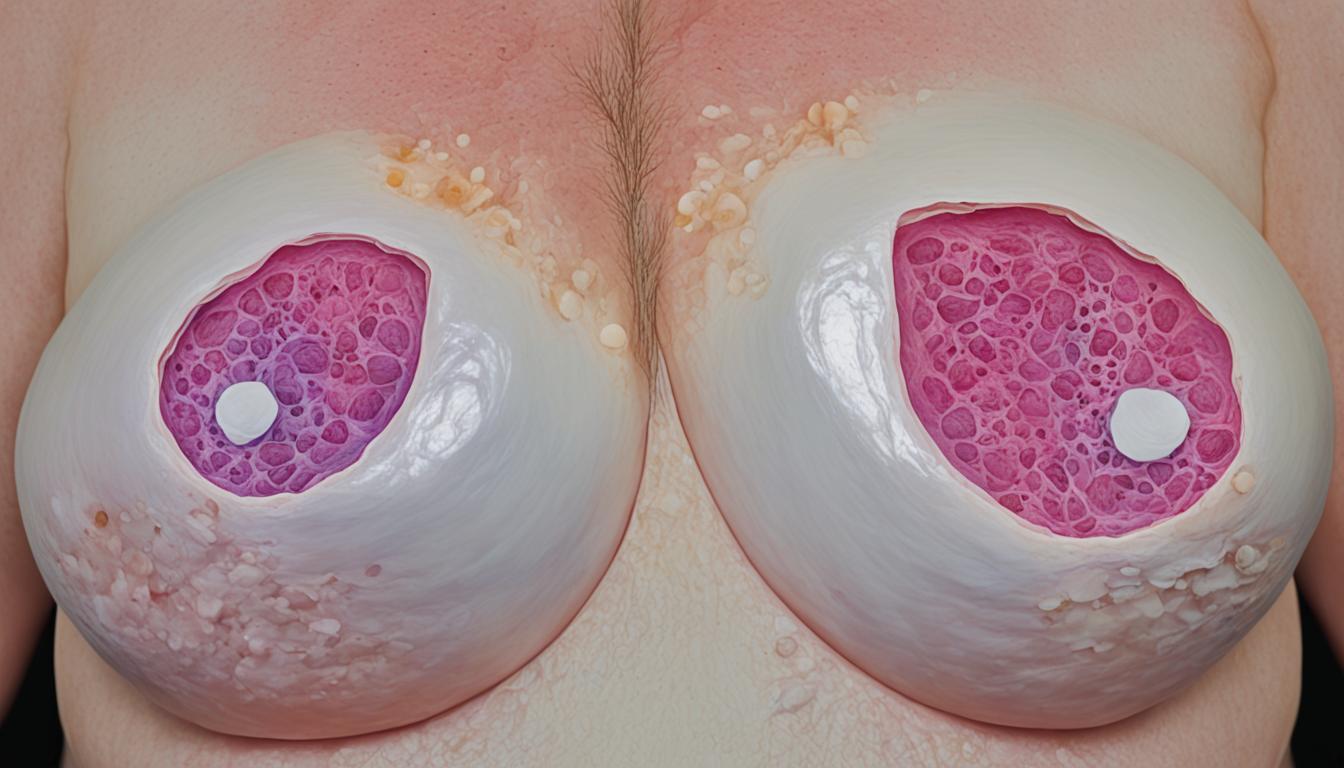Fibroadenoma is a common, non-cancerous tumor found in the breast. It mainly affects young women under 30. This tumor is made of fibrous and glandular tissues, linked to the hormone estrogen.
These tumors can feel like a single lump, though they might be multiple. They’re usually smooth, firm, and can move around. The size can vary from a mere centimeter to five. They’re often found through self-exams and might feel sore or grow before periods.
To diagnose, doctors perform a physical check, ultrasound, and a biopsy. Most fibroadenomas disappear on their own. But, for larger or bothersome ones, surgery may be needed. Experts are also looking into using stem cell therapy for treatment.
Key Takeaways:
- Fibroadenoma is a common benign tumor of the breast.
- It primarily affects women under the age of 30.
- Fibroadenomas are composed of fibrous and glandular tissue.
- Symptoms include single or multiple lumps that are smooth, firm, and mobile.
- Diagnosis is typically confirmed through a physical examination, breast ultrasound, and biopsy.
- Larger or symptomatic fibroadenomas may require surgical removal.
- Stem cell therapy is being researched as a potential treatment option.
Causes and Risk Factors of Fibroadenoma
Fibroadenomas happen due to estrogen imbalances in the body, with the exact cause unclear. They mainly affect premenopausal or pregnant women and those in hormone therapy.
These lumps may come and go with the menstrual cycle. This hints at how hormone shifts might be linked to their appearance. Estrogen, important for the health of female reproductive organs, seems to aid their growth.
Fibroadenomas are more common among younger women, especially African-Americans. The higher rate in this group suggests a genetic influence. Family history is a known risk, increasing chances for those with a relative who had fibroadenomas.
Key Factors:
- Estrogen Influence
- Hormone Replacement Therapy
- Menstrual Cycle
- Race
- Family History
Knowing about fibroadenoma’s causes and risks aids in their better handling by health experts. Yet, much more research is necessary. This will help understand how estrogen levels and genetics truly affect fibroadenomas.
Comparison of Fibroadenoma Risk Factors:
| Risk Factors | Influence |
|---|---|
| Estrogen Levels | High |
| Hormone Replacement Therapy | Elevated Risk |
| Menstrual Cycle | Hormonal Fluctuations |
| Race | Higher Prevalence in African-American Women |
| Family History | Increased Risk |
Symptoms, Diagnosis, and Treatment of Fibroadenoma
Fibroadenomas are often found when doing a breast self-examination. They feel firm, round, smooth, and can move around. These lumps might hurt or swell up before your period, which worries or bothers many women. Knowing the symptoms and getting medical help quickly is key to the right treatment.
Diagnosis involves a full check-up. This includes a physical exam, breast ultrasound, and mammogram. Doctors look at the shape, feel, and mobility of the lump during the exam. Imaging tests give them a closer look at your breast. Mammograms are very important for older women or those with a higher breast cancer risk.
A biopsy is the next step to be certain. A fine needle aspiration biopsy is usual. A small needle takes samples from the lump. These samples are then checked under a microscope for detailed study.
The treatment path depends on the lump’s size, symptoms, and biopsy outcomes. Small, painless ones might just need checking with ultrasounds. But, larger ones that hurt or affect your life might need surgery.
Lumpectomies are often done for bigger or symptomatic fibroadenomas. This surgery takes out the lump but keeps the rest of the breast. It’s usually done with local anesthesia. This means a quicker recovery and less scarring.
Recently, stem cell therapy has become an area of interest. It’s not yet a common treatment. Stem cells might offer new, easier ways to deal with fibroadenomas. Research is ongoing to find out more about this treatment.
| Fibroadenoma Treatment Options | Benefits |
|---|---|
| Lumpectomy | – Removes the fibroadenoma – Preserves breast tissue – Minimal scarring |
| Stem Cell Therapy | – Potential less invasive option – Promising research findings – Explore alternative treatment methods |
Though fibroadenomas are usually not cancerous, it’s important be proactive. Doing regular breast self-exams and knowing the signs is vital. This leads to early treatment and peace of mind.
Keep reading to find out more about fibroadenomas and their outlook in the final part of the article.
Conclusion
Fibroadenomas are common in younger women. They are non-cancerous. Yet, they can affect breast health and cause discomfort.
Early detection is key. Regular self-exams and knowing the symptoms are crucial.
Diagnosis includes tests like physical exams and biopsies. Treatment varies based on the fibroadenoma’s size and symptoms. Surgery is often used for removal. Stem cell therapy shows promise for the future.
It’s essential to raise awareness about breast health. This helps catch fibroadenomas early. By checking for symptoms regularly, women can get medical help if they notice any changes.
Regular check-ups are also important. Healthcare professionals can help monitor fibroadenomas. They can also create a treatment plan that’s right for each woman.
Fibroadenomas are manageable with the right care. With early diagnosis and medical attention, women can take charge of their breast health.

